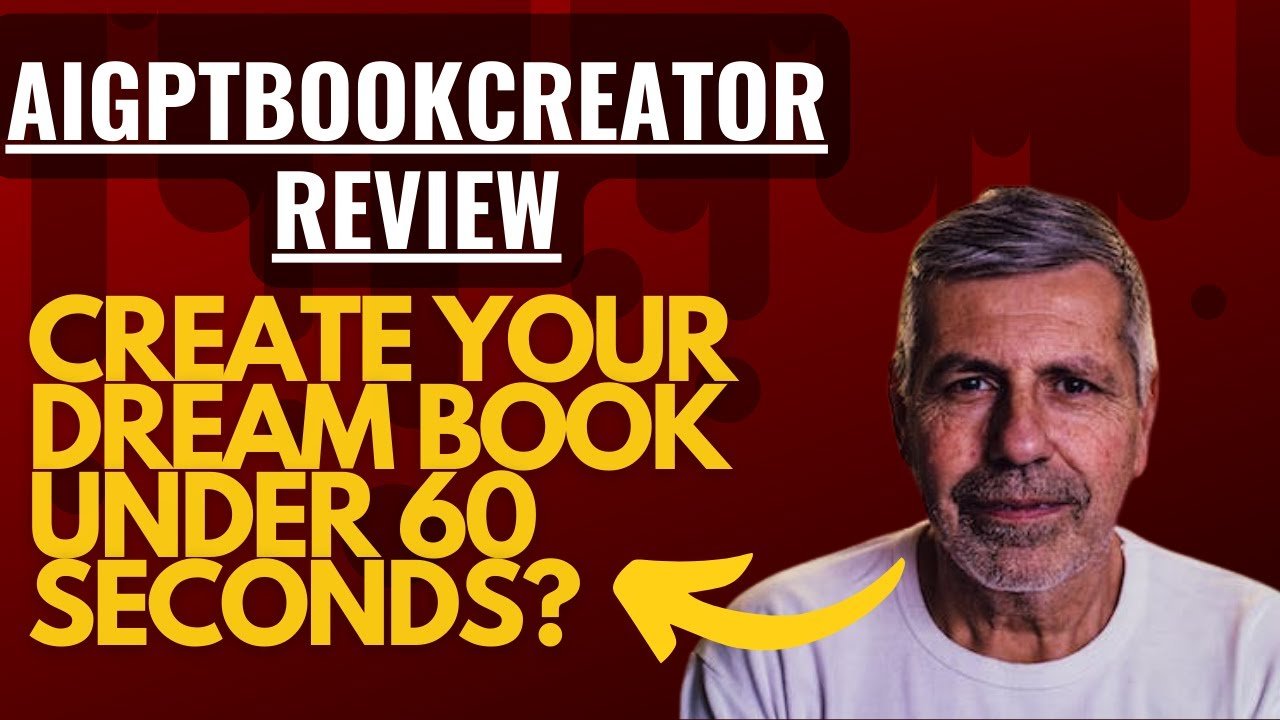As a blogger who’s been churning out content for years, I’ve always been on the hunt for tools that make writing faster, easier, and more fun. Between juggling deadlines, brainstorming ideas, and trying to keep my readers hooked, the process can feel like herding cats. So when I stumbled across AiGPTBookCreator, a tool promising to streamline book and content creation with AI, I was intrigued but skeptical. Could this really be the game-changer it claims to be? After spending weeks diving deep into its features, I’m ready to spill the tea in this AiGPTBookCreator review. Spoiler alert: it’s been a wild ride, and I’ve got plenty of thoughts to share.

If you’re curious about whether this tool lives up to the hype or if it’s just another shiny promise in the crowded world of AI writing tools, stick with me. I’ll walk you through my experience, the pros and cons, and whether AiGPTBookCreator is worth your time (and money). Let’s dive in!
What Is AiGPTBookCreator?
Before I get into the nitty-gritty, let’s cover the basics. AiGPTBookCreator is an AI-powered writing tool designed to help creators—think authors, bloggers, and entrepreneurs—craft books, blog posts, and other content with ease. It leverages advanced AI (think along the lines of GPT models) to generate ideas, outlines, and even full drafts based on your prompts. Whether you’re writing a novel, a self-help guide, or a series of blog posts, the tool aims to take the heavy lifting out of the process.
What caught my eye initially was its bold claim: you can go from a vague idea to a polished manuscript in a fraction of the time it’d normally take. As someone who’s spent countless late nights staring at a blinking cursor, that sounded like a dream come true. But I’ve been burned by overhyped tools before, so I went in with my guard up.
To give it a fair shot, I signed up through this link and started exploring. The interface is clean and intuitive, which is a big plus for someone like me who doesn’t have the patience for clunky software. But looks can be deceiving, so let’s talk about what it actually does.
My First Impressions: Getting Started with AiGPTBookCreator
Setting up AiGPTBookCreator was a breeze. After signing up, I was greeted with a dashboard that felt like a mix between a writing app and a creative brainstorming hub. You can start a new project by selecting the type of content you want to create—fiction, non-fiction, blog posts, or even scripts. I decided to test it with two projects: a short e-book on productivity hacks (non-fiction) and a fictional short story to see how it handles creative writing.
The first thing I noticed was the prompt system. You input a brief description of what you want, and the AI generates an outline or draft. For my e-book, I typed something like, “A guide to productivity for busy bloggers with practical tips.” Within seconds, AiGPTBookCreator spit out a detailed outline with chapter titles like “Mastering Your Morning Routine” and “Hacking Your To-Do List.” I was impressed by how specific it was—it didn’t feel like generic fluff.
For the short story, I gave it a tougher challenge: “A sci-fi tale about a lone astronaut stranded on a mysterious planet.” The AI came up with a surprisingly gripping opening scene, complete with vivid descriptions of an alien landscape. I won’t lie; I got a little excited. Could this tool really make writing this effortless? Well, not so fast—there were some hiccups, which I’ll get to later.
Read more: Make Money From Your Phone Today – Proven Methods for Immediate Earnings
The Good Stuff: What I Loved About AiGPTBookCreator
Let’s start with the highlights because, honestly, there’s a lot to like here. After spending hours tinkering with the tool, here are the features that stood out to me.
1. Speed and Efficiency
If you’re someone who dreads the blank page, AiGPTBookCreator is like a trusty sidekick. The speed at which it generates ideas, outlines, and drafts is mind-blowing. For my productivity e-book, I went from a one-sentence idea to a 10-chapter outline in under five minutes. Compare that to the hours I’d normally spend brainstorming, and it’s a no-brainer why this tool is a time-saver.
Even better, it doesn’t just stop at outlines. You can ask it to flesh out entire sections, and while the results aren’t always perfect (more on that later), they give you a solid starting point. For busy creators who need to pump out content fast, this is a huge win.
2. Versatility for Different Projects
One thing I appreciated was how versatile AiGPTBookCreator is. Whether you’re writing a technical guide, a fluffy romance novel, or a blog post, it adapts to your needs. I tested it across genres, and while it’s stronger in some areas (non-fiction felt more polished than fiction), it handled everything I threw at it with decent results.
For bloggers like me, the ability to generate blog post ideas and drafts is a lifesaver. I used it to brainstorm a list of “10 Ways to Stay Motivated as a Blogger,” and the suggestions were surprisingly practical—stuff I’d actually write about. If you’re stuck in a content rut, this tool can spark some serious inspiration.
3. User-Friendly Interface
I’m not a tech wizard, so I need tools that are easy to navigate. AiGPTBookCreator delivers on that front. The dashboard is clean, with clear options for starting new projects, editing drafts, or exporting your work. There’s also a handy feature that lets you tweak the tone of the writing—formal, casual, or even humorous. I had fun playing with the humorous setting for a blog post, and the results were cheeky enough to make me chuckle.
4. Collaboration with Human Creativity
Here’s where I started to fall for AiGPTBookCreator: it doesn’t try to replace you. Instead, it feels like a creative partner. The AI generates the raw material, but you’re still in the driver’s seat, editing and shaping the content to match your voice. For my e-book, I used the AI’s draft as a foundation and then added my personal anecdotes and flair. The result? A manuscript that felt authentically me but took half the time to write.
If you’re worried about AI making your work sound robotic, don’t be. With a bit of editing, you can make the output sound as human as anything you’d write from scratch. Plus, the tool learns from your inputs over time, so the more you use it, the better it gets at matching your style.
5. Affordable for What You Get
I won’t spill the exact pricing here (it varies based on plans), but I will say that AiGPTBookCreator is reasonably priced for the value it offers. Compared to hiring a ghostwriter or spending months writing a book manually, it’s a steal. You can check out the plans yourself through this link to see what fits your budget.
The Not-So-Great Stuff: Where AiGPTBookCreator Falls Short

No tool is perfect, and AiGPTBookCreator has its quirks. While I’m a fan overall, there were a few moments that made me raise an eyebrow. Here’s what didn’t quite hit the mark.
1. Inconsistent Quality in Creative Writing
While the tool shines with structured content like non-fiction or blog posts, it’s hit-or-miss with creative writing. My sci-fi short story started strong, but as the AI kept generating, the plot got a bit wonky—think random character motivations and cliched dialogue. It’s not a dealbreaker, but if you’re writing fiction, expect to do some heavy editing to keep things cohesive.
I suspect this is because creative writing requires a level of nuance and emotional depth that AI still struggles with. For now, I’d say AiGPTBookCreator is better suited for factual or instructional content, though it can still give you a decent starting point for fiction.
2. Occasional Generic Output
Sometimes, the AI’s output feels a little too… safe. For example, when I asked for blog post ideas on “unique travel destinations,” some of the suggestions were predictable, like “Paris” or “Bali.” It’s not a huge issue, but it means you’ll need to push the AI with more specific prompts to get truly original ideas.
My workaround? Be as detailed as possible in your prompts. Instead of “write a blog post about travel,” try “write a blog post about off-the-beaten-path hiking trails in South America.” The more context you give, the better the results.
3. Learning Curve for Advanced Features
While the basics are easy to grasp, some of the advanced features—like customizing the AI’s tone or integrating it with other tools—take a bit of trial and error. I spent a good hour figuring out how to export my draft to Word without losing formatting. The help section is decent, but I wish there were more beginner-friendly tutorials.
If you’re not super tech-savvy, you might feel a tad overwhelmed at first. That said, once you get the hang of it, these features add a lot of value.
4. Dependence on Editing
Let’s be real: AI isn’t going to write a Pulitzer Prize-winning novel on its own. While AiGPTBookCreator produces solid drafts, they almost always need polishing. For my e-book, I spent a good chunk of time rephrasing sentences and adding personal touches to make it sound less formulaic.
This isn’t a huge drawback—after all, editing is part of the writing process—but if you’re expecting publication-ready content straight out of the gate, you might be disappointed.
Read more: Viral Pages AI Review – A Comprehensive Insight Analysis
How AiGPTBookCreator Stacks Up Against Other AI Writing Tools
To give you a fuller picture, I compared AiGPTBookCreator to a couple of other AI writing tools I’ve tried, like Jasper and CopyAI. Here’s how it measures up:
Vs. Jasper: Jasper is great for marketing copy and blog posts, but I found AiGPTBookCreator more intuitive for long-form content like books. Jasper’s tone options are robust, but AiGPTBookCreator’s project-based approach (e.g., organizing chapters) gives it an edge for authors.
Vs. CopyAI: CopyAI is fantastic for quick social media posts or email drafts, but it’s not built for book-length projects. AiGPTBookCreator’s ability to handle both short and long content makes it more versatile for creators with diverse needs.
That said, each tool has its strengths, and your choice depends on what you’re creating. For bloggers and authors tackling bigger projects, I’d lean toward AiGPTBookCreator.
Who Should Use AiGPTBookCreator?
After weeks of testing, I can confidently say AiGPTBookCreator is a solid fit for:
Bloggers who need to churn out content quickly without sacrificing quality.
Aspiring authors who want to write a book but feel overwhelmed by the process.
Entrepreneurs creating e-books, whitepapers, or guides to establish authority in their niche.
Content creators looking for a tool to spark ideas and streamline their workflow.
If you’re a perfectionist who loves crafting every sentence from scratch, this might not be your cup of tea. But if you’re open to collaborating with AI to save time and boost productivity, it’s worth a look.
Read more: Discover the Ultimate Website That Pays Daily – Your New Income Source Awaits!
My Final Verdict: Is AiGPTBookCreator Worth It?
So, here’s the million-dollar question: should you give AiGPTBookCreator a try? For me, the answer is a resounding yes, with a few caveats. This tool has shaved hours off my writing process, helped me overcome writer’s block, and made tackling big projects feel less daunting. The versatility, speed, and user-friendly interface are major wins, and the affordable pricing doesn’t hurt either.
That said, it’s not a magic bullet. You’ll need to put in some editing work, especially for creative projects, and there’s a slight learning curve for advanced features. But if you’re willing to roll up your sleeves and treat the AI as a partner rather than a replacement, the results can be pretty darn impressive.
I’m already planning to use AiGPTBookCreator for my next e-book, and I’m excited to see how it evolves as the team behind it rolls out updates. If you’re curious about trying it yourself, I’d recommend starting with a free trial to see if it clicks for you. You can sign up through this link and explore the features firsthand.
Tips for Getting the Most Out of AiGPTBookCreator
Before I wrap up, here are a few tips based on my experience to help you hit the ground running:
1. Be Specific with Prompts: The more details you provide, the better the AI performs. Don’t be afraid to get granular.
2. Edit with Your Voice in Mind: Use the AI’s output as a starting point and infuse it with your personality to make it authentic.
3. Experiment with Tones: Play around with the tone settings to find what works for your audience—casual, professional, or even quirky.
4. Start Small: If you’re new to AI writing tools, try a short blog post before diving into a full book project.
Wrapping Up My AiGPTBookCreator Review
Writing this AiGPTBookCreator review has been a blast because it forced me to reflect on how much this tool has changed my workflow. It’s not perfect, but it’s darn close to being a must-have for anyone who creates content regularly. Whether you’re a blogger like me, an aspiring author, or a business owner looking to crank out professional content, AiGPTBookCreator can save you time and spark your creativity.
I’d love to hear your thoughts—have you tried AiGPTBookCreator or another AI writing tool? Drop a comment below and let me know what’s worked for you. And if you’re ready to give it a spin, you can check it out through this link. Happy writing, friends!






